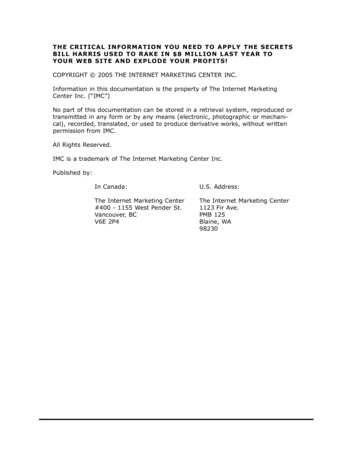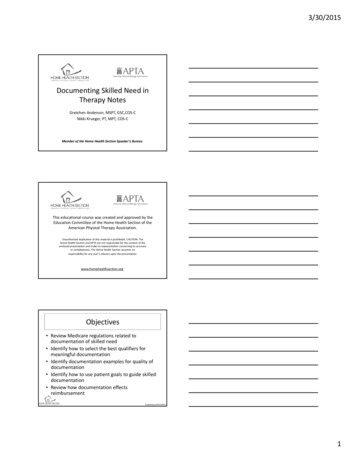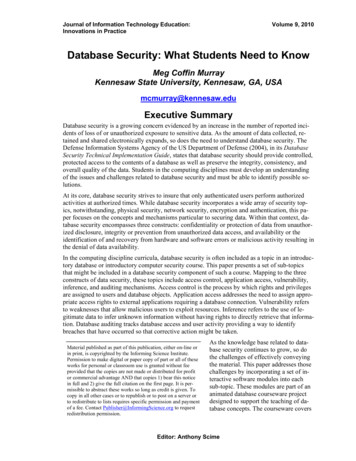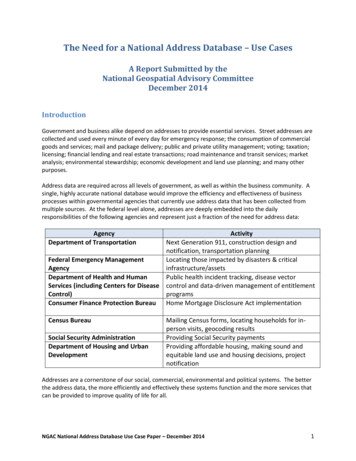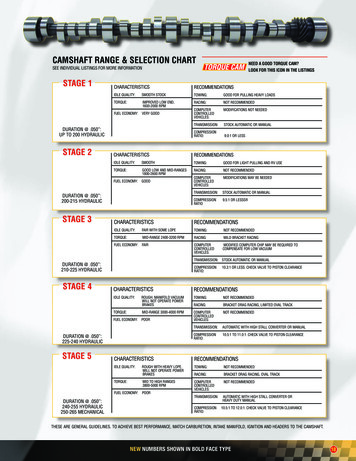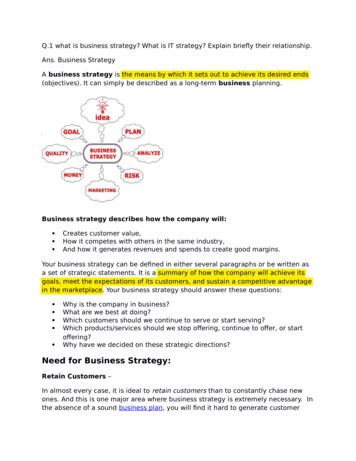
Transcription
Q.1 what is business strategy? What is IT strategy? Explain briefly their relationship.Ans. Business StrategyA business strategy is the means by which it sets out to achieve its desired ends(objectives). It can simply be described as a long-term business planning.Business strategy describes how the company will: Creates customer value,How it competes with others in the same industry,And how it generates revenues and spends to create good margins.Your business strategy can be defined in either several paragraphs or be written asa set of strategic statements. It is a summary of how the company will achieve itsgoals, meet the expectations of its customers, and sustain a competitive advantagein the marketplace. Your business strategy should answer these questions: Why is the company in business?What are we best at doing?Which customers should we continue to serve or start serving?Which products/services should we stop offering, continue to offer, or startoffering?Why have we decided on these strategic directions?Need for Business Strategy:Retain Customers –In almost every case, it is ideal to retain customers than to constantly chase newones. And this is one major area where business strategy is extremely necessary. Inthe absence of a sound business plan, you will find it hard to generate customer
loyalty. Businesses that have no specific guidelines on how to cater to existingcustomers risk alienating the later, and a competitor can easily snatch them out ofyour hand just by emphasizing on customer service.Robust System of Follow up –So, what you need to do is develop a robust system of follow-up where calls aremade and emails are sent to repeat customers not only to ensure that theirproducts are operating properly, but also to let them know that your business caresfor them. And depending on your line of your business, you can also send greetingcard and gifts to repeat clients on occasions like Christmas.Resource Allocation:Another place in which a business strategy comes in handy is resource allocation,as mentioned in the opening. Your business, no matter how big, will always havelimited resources on hand, which necessities the need of efficient management sothat these resources can be used with maximum efficacy. A sound business planhelps you weave together resources like employees, brand value,clientele, trademarks, and supply partners etc, to achieve a competitive advantageand also create products and promotion that speaks directly to your target market.If resources are not managed efficiently, then the business is likely to lose bothrevenue and customers in the long run.Business Expansion:Thirdly, business expansion is also a goal which cannot be achieved withoutstrategy. If your expansion goals are laid out in great detail, then it will help teamleaders and executives to explore opportunities outside of your standard businesspractice to facilitate company expansion. You will be able to set aside budget andhire appropriate people for market research that can not only collect and collatedata, but also analyze trends to help you spot untapped niches.Clarity, focus and direction.If you have a business strategy in place you will be clear on where your business isnow, where it is going and what you need to do to get there. This will give yourbusiness clarity, focus and direction as you can align the business to achieving thebusiness strategy. You will be making your business strategy happen rather thanletting your business drift along without purpose.A better understanding of your current business.To develop a business strategy you need to understand where your business is now.This involves looking at your business overall, including the key internal drivers suchas financial performance, customer satisfaction, staff turnover, sales and marketing
trends, conversion rates etc. You will also need to consider the strengths,weaknesses, opportunities and threats associated with your business andunderstand the external business environment, your competitors and the marketyou are in. This will all put your business in a much better place to move forward.Better business results.Developing a business strategy is likely to lead to better business performance asyou are focused on taking the business to where you want it to be. You are lesslikely to get distracted and waste time on areas that are not moving you towardsyour long term objectives.IT Strategy:IT strategy is a comprehensive plan that information technology managementprofessionals use to guide their organizationsIT strategy is the discipline that defines how IT will be used to help businesses winin their chosen business context.IT Strategy is: A long-term action plan for achieving a goal. Those which not only link to a business strategy, but also combine tactics andlogistics It is about how IT will help the organisation win in its chosen markets. An IT strategy should cover all facets of technology management, including Cost Management Capital Management Hardware / Software Management Vendor Management Risk ManagementAn IT Strategy should answer the following questions: Are we doing the right things with technology to address the organization’smost important business priorities and continuously deliver value to the clients?
Are we making the right technology investments? Do we measure what is the real value to the organization derived from thattechnology?Is our current Information Technology agile enough; flexible to continuously support a successful organization?Is our Information Technology environment properly managed, maintained, secured, able to support the clients, and is it cost effective?Can our strategy support current and future business needs? understanding the aims and objectives of the business establishing the information requirements outlining the systems needed to provide the information determining the role of information technology in supporting the informationsystems agreeing policy, priorities and development and implementation plans managing, reviewing and evolving the strategy, and planning to managepotential impacts such as the effect on culture and organization An information technology strategy brings this information together into a planto make the most appropriate use of both information and technology availablein an organisationRelationship:
Q 2. What do you understand by the term “context of business”? Explainbriefly the stepsinvolved in arriving at the IT Strategy after understanding the context ofbusiness?Ans. Business ContextPlayers: People, Organization and SystemsExplain what business means. Understanding your business, Understandexternal and internal factors and all. That will finish ur Context part. Context of business is environment in which a business operates. Environmental scanning mainly focuses on the macro environment of a business. Butcontext analysis considers the entire environment of a business, its internal and externalenvironment. SWOT analysis helps us to understand context of business. The main goal of a context analysis, SWOT or otherwise, is to analyze theenvironment in order to develop a strategic plan of action for the business.Workforce planning needs to be directly linked to you business goals, and so the firststep is to think about your own business context. Ask yourself the following questions:1.What are my business goals and vision?2.Where is my business heading? Is it growing, downsizing, transitioning, shiftingskills, introducing new technology or is it in a maintenance mode?3.What are the economic conditions that impact on my industry sector and marketsand does this impact on my business?4.Who are my customers/clients?5.What is going on internally in my business and how will this impact on myworkforce requirements?6.What are the short, medium and long term goals for my business and whatworkforce skills and capability will I need to achieve these business goals?Having a good understanding of the current environment and context of the industryyour business is operating in, as well as your goals for the future of your business, willhelp you to plan your workforce needs and develop strategies to turn your goals intobusiness success.Steps for arriving at an Effective IT strategy.#1 - Review Strategic and Tactical Goals and align with the TechnologyProjects and Goals.
Developing an effective technology strategic plan should first start with a review ofthe organization’s strategic plan. Often after listing out the strategic plans andtactical plans of the organization, the areas where technology could enhance orenable such plans becomes apparent. Many organizations that have reached thestate where their IT planning is pro-active rather than reactive have used thestrategic plans and tactical plans as the litmus test for whether a project should befunded. When reviewing projects during the budget process, consideration shouldbe given to whether the project contributes to achieving the strategic goals of theorganization.Example: If one of your strategic goals is to become “a premier provider of healthcare services”, how is that goal going to be achieved? What is a premier provider,and what tools would enable your health care staff to become just such a provider?#2 – Interview the Executive and the Operational StaffAfter reviewing the organizations Strategic Goals, the next step is to collectinformation from the executive and operational staff. This information should becollected in a variety of ways so that common themes can be extrapolated, and thatthe analysis shows trends and direction. Often people will open up more inindividual interviews and others will tend to do better in group settings. We oftenuse the following tools to collect data when helping clients create IT strategic plans: Questionnaires and Surveys Strengths/Weaknesses/Opportunities/Threats (S.W.O.T.s) Individual Interviews (Executive and selected staff) Departmental Interviews Interviews with the Board of Directors and Resident GroupsThe data collected during the process above is then entered into spreadsheets andsorted for common or consistent themes. Example: The survey questions aredesigned to ask the users of the IT systems to rank their opinions about the mindsetof the organization as far as IT investment is concerned. The data collected mightbe sorted to show the following common issues: The organization as a whole has a desire to be perceived as an “Innovator orEarly Adopter” in their use of IT The current state of IT in comparison to other senior living communities is closerto “Laggard or Late Majority” Technology that is currently available to the community is not being usedproperly, indicating the reasons (e.g. a lack of training or limited support)
#3 – Benchmark the Current IT Organization and IT SpendingThe benchmarking exercise may include the following aspects: IT Leadership – does your company have a CIO or IT Director in strategic planningand growth? Is IT Leadership proactive or reactive? What is the size and scope of the current IT organization? How does this compareto other similar senior living providers? Rank your internal IT staff andresponsibilities in comparison to similar senior living providers to determine if yourorganization is a leader, follower, or laggard in providing IT solutions to yourcompany. Benchmark IT spending against other Senior Living providers to see how yourorganization invests their IT dollars. We typically find that many senior livingproviders “think” they are spending enough on IT, but they are really laggards incomparison to senior living organizations that view IT as a strategic investment overtheir competitors.Example: Take a critical look at how IT is funded in your organization and askyourself the following questions: Is Information Technology considered a “cost” of doing business or an “enabler” ofthe business to succeed? Are projects funded based on proactive or reactive thinking? Do you replace systems when they break or are there multi-year plans to upgradesystems? Do you include IT leadership on the organization’s Executive team? How are new corporate directives and goals communicated to IT? Would outsourcing some or all of IT for your organization lower IT expenditures?#4 – Software Application and Systems ReviewThe best way to start the process is to identify all the applications currently in use inthe organization and determine the following: Review each application anddetermine with the users if the application is meeting the current needs: o Who arethe “owners” of the application? o What are the needs of the current “owners”? oReview the current application and identify where the current application is meetingor not meeting the needs of the department o Determine when the application
could be considered for replacement or enhancements (based on not meetingneeds, purchase date, regulatory requirements)#5 – Review the Gaps between the Strategic Goals and the CurrentOperationsThis is where the fun begins. You have reviewed the strategic goals of yourorganization and identified IT related goals. You have interviewed the executive andoperational staff to get their input into the IT needs of the organization as well asthe current performance of the IT operations team and systems. You have reviewedthe existing IT organization, staff and budget and have reviewed the current list ofapplications and determined whether they are meeting the current needs of theorganization, and explored some upgrade or replacement options. Armed with thisinformation, the next steps are to identify the gaps between the desired state andthe current state of the IT organization.#6 – Develop the IT Short-Term and Long-Term Project Plan/TimelineWith the gaps identified, you can now prioritize projects over a multi-year periodand create that elusive long-range technology vision. Because of the dependenciesupon other IT projects, this is best done by IT staff or consul
And depending on your line of your business, you can also send greeting card and gifts to repeat clients on occasions like Christmas. Resource Allocation: Another place in which a business strategy comes in handy is resource allocation, as mentioned in the opening. Your business, no matter how big, will always have limited resources on hand, which necessities the need of efficient management .

